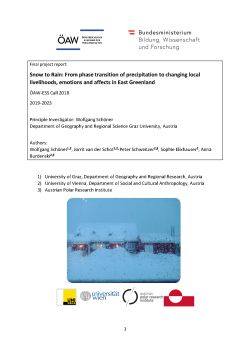|
 |
Snow2Rain investigated the impacts and perception of climate change in East Greenland through a holistic approach that includes natural science methods of time series analysis and statistical climatology on the one hand, and social science approaches of social anthropology on the other. In addition, this interdisciplinary approach was based in a transdisciplinary framework by involving the local people in Tasiilaq (East Greenland) and their knowledge. Based on the intention to study the effects of climate close to the everyday life of the locals, snow was chosen as one such interdisciplinary indicator of climate change. In addition, Greenland, as the study site of Snow2Rain, is a region in the Arctic and thus affected by Arctic amplification (implying a temperature increase of about three times the global average). With this in mind, Snow2Rain examined changes in snow characteristics in East Greenland and their underlying mechanisms, and placed these changes in the context of social and cultural as well as socioeconomic impacts for local people.
From the main results of Snow2Rain, it can be concluded that (i) Arctic amplification is less pronounced compared to other regions in the Arctic and therefore climate change impacts (e.g., changes in snowpack, transition from snowfall to rain) are less pronounced and co-determined by precipitation changes. The strongest signals for the transition from snow to rain were found for the summer season. In addition, the most important climate change events currently discussed by locals in Tasiilaq are the storm winds known as piteraqs and icequakes (earthquakes triggered by calving glaciers).
There is considerable interest in scientific information about meteorological and climate conditions as well as changes in the community of Tasiilaq, even though the topic of climate change is not the most pressing issue within the community. It also became clear that local knowledge holders from Tasiilaq hold relevant knowledge about past snow and environmental conditions (e.g. stories about snow conditions along dogsledding routes), but several challenges exist that make it a complex task to make this knowledge usable for climate scientists. To give a few examples of the existing knowledge, there is a lot of relevant knowledge about changes in wind direction and wind speed, and particularly a lot of memories exist in relation to extreme wind events (piteraqs and other storm winds).
Overall, the perception of climate change in Greenland is different than in Europe (the recent signing of the Paris Agreement seems to be a clear reflection of this). People from Tasiilaq region are very sensitive in observing changes of their environment including the climate. Snow is only one of those changes observed (wind/storms and earthquakes are currently widely discussed by the locals). However, they speculate much less about future changes and are cautious about the human influence on climate change.
|



 Home
Home Print
Print
 References
References
 Share
Share
